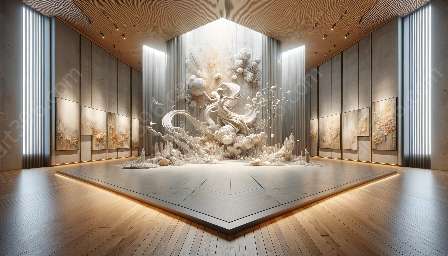Art installations have become a crucial medium for expressing cultural identity, offering a unique platform to explore and represent diverse cultural narratives. These installations not only preserve and celebrate cultural heritage, but also provide a space for critical reflection on the complex connections between art and cultural identity.
Understanding Cultural Representation in Art Installations
Art installations are dynamic and immersive artistic expressions that often incorporate various mediums, from visual arts to performance and interactive elements. They offer a multi-sensory experience, which becomes a powerful tool for conveying cultural representations. Through the use of symbolism, storytelling, and aesthetics, art installations bring to life the cultural essence of communities, regions, and specific social groups.
Exploring the Interplay between Art Installations and Cultural Identity
The relationship between art installations and cultural identity is complex and multifaceted. Art installations serve as a reflection of cultural heritage, traditions, and contemporary identity, providing a way for artists to engage with and respond to the sociocultural landscape. By examining the themes, materials, and techniques employed in art installations, we can uncover deeper insights into the interconnectedness between art and cultural representation.
The Role of Art Installations in Cultural Identity Preservation
Art installations play a significant role in preserving cultural identity by capturing and showcasing various aspects of culture. These installations act as living archives, embodying the traditions, beliefs, and values of different communities. They become a means of passing down cultural knowledge to future generations and serve as a visual testament to the diversity of human expression.
Art Installations as Agents of Cultural Dialogue
One of the defining features of art installations is their ability to initiate conversations and dialogues about cultural identity. By creating immersive and participatory environments, they encourage viewers to engage with different cultural narratives, fostering empathy, understanding, and appreciation for diversity. This dialogue fosters a sense of shared humanity, while also honoring the intricacies and nuances of various cultural experiences.
Celebrating Cultural Diversity through Art Installations
Art installations celebrate the richness of cultural diversity by offering a platform for artists to express their unique cultural perspectives. They provide a space for marginalized voices to be heard and for underrepresented narratives to be brought to the forefront. Through these installations, cultural identity becomes a source of empowerment, enabling individuals to reclaim and redefine their place in the cultural tapestry.
Art installations stand as powerful visual and experiential testaments to the complex interrelationships between art and cultural identity. They encapsulate the essence of cultural representation, serving as mirrors reflecting the multifaceted nature of human experience. By delving into the world of art installations, we can gain a deeper appreciation for the richness and diversity of cultural identities, and the ways in which these identities are continually shaped and expressed through art.
